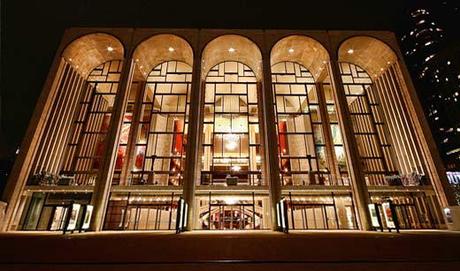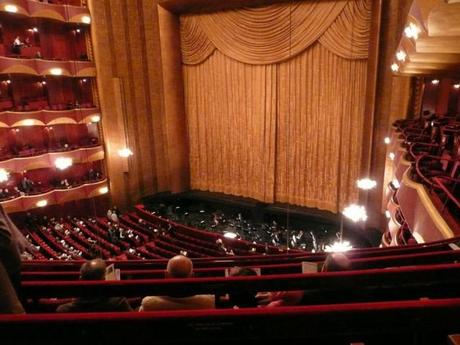
The Metropolitan Opera House at night from Lincoln Center Plaza.
The Metropolitan Opera's 2010-2011 season just ended. So now's a good time to go over some of the basics of going to the opera, including some hints navigating the company's labyrinthine ticketing systems for 2011-2012.When should I go?
The Met "season" runs from the last week in September to early-or-mid-May. The house is usually open for performances Monday through Saturday with two performances on Saturday. Being an opera-goer is much like being a sports fan--if you enjoy the activity there's no limit on how many times you can attend. I average about 30 shows a year, and write about almost all of them--and that's just the Met.
What should I see first?
This blog tries its damnedest to answer that question with "Metropolitan Opera Previews" that usually run on the site about a week before the prima (the first performance in a run). Generally, Italian opera is good to start with--Verdi, Puccini or Rossini. French opera (especially Carmen) is always popular. Get into the art form, and then experiment with German opera (a passion of mine), works by Russian or Czech composers, or baroque works.
How will I understand what is going on?In 1993, the Met added the "MET Titles" system to the house, little computer-controlled screens at your seat that provide a running translation of the opera. Currently, Met Titles are offered in English, German and Spanish at the touch of the button. If you don't want to be distracted, turn them off.

View from the right side of the house from the Dress Circle. Those red railings are the titles system.
How do I order tickets?Tickets for Met performances are available to the general public starting in mid-August and throughout the season. You can order them through the official web site, by calling the Met box office, or by going to the box office, located in the lobby of the opera house on the north side of the theater. At the window, the Met does not charge the same "handling fees" as phone and web orders.
Should I subscribe?
If you like opera enough to see six or seven performances a year, yes!
Subscribers get the benefit of having their tickets mailed to them without having to spend the same handling fees as for individual orders. Tickets are 25% cheaper. For example, my $30 seats in the Family Circle are $40 if I order them as individual performances, plus the added handling fees.
That sounds like too much.
The Met also offers 3 or 4-opera mini-subscriptions for opera lovers getting their feet wet. Also, subscribers have the option to order extra tickets earlier than the general public, and can exchange their tickets (for a small per-ticket fee) at any time during the season.
What does it cost?

Orchestra: $95-205.
Parterre Boxes: $130-430.
Grand Tier: $95-120.
Dress Circle: $80-$175.
Balcony: $25-100.
Family Circle: $25-$35.
Lowest numbers reflect the cost of partial-view seats. Ticket prices are slightly higher for Friday and Saturday performances.
Good God! Are there any cheap seats?
Yes! Here are some options.
- It is cheaper to sit in the partial-view box seats on the side of the house on all upper levels. Tickets cost the same on the sides as they do at the main seating above. For example, Dress Circle seats cost $100 for full view, and $60 for partial--same as the Balcony above it.
- Standing Room (offered in the Orchestra and Family Circle) is an option for the athletic or the dedicated opera-goer. The Family Circle is a better, cheaper experience.
- The Met also offers 150 "rush tickets" (in the orchestra seating) for every weekday performance (except for premieres.) The "rush line" forms on the Lincoln Center concourse at 12pm. You have a good shot at tickets if you get there by 3. Tickets are sold ($20 apiece) at the box office at 6:30pm, first come, first served. A very limited number of rush tickets are available (by lottery) for weekend performances through the website.
- It is sometimes possible to score tickets to a dress rehearsal from a Patron or through random lottery draw on the Met website. These performances are at 11am and are not always open to the general public.
- Finally, "score desk" seats (located on the Family Circle level at the very top of the house with no view of the stage) are available through the Metropolitan Opera Guild's Educational Dept.

The Met's gold-leaf ceiling with its galaxy of Swarovski chandeliers.
Can't I just go see the opera in a movie theater?If you can't physically make it to the Metropolitan Opera House, the company offers several HD broadcasts (shown at a movie theater near you) throughout the seasons. They are usually on Saturday afternoon with an encore later in the month. Tickets sell for about $20 a seat, and you get a nice intermission interview with the artists and a look at the backstage machinations of the Met. Not a bad deal--but not the same electric thrill of being at a live opera performance.
I'm coming from work. Do I have to "dress up?"
Members of the Metropolitan Opera Club are required to wear black tie. But that's a private club with a membership fee in five figures, and they all sit in the same part of the theater (hence the name "dress circle." The general public can wear anything--though it's a good idea to dress neatly. At the minimum, jeans and a t-shirt are OK as long as they are clean, neat and free of decoration.
What is the Metropolitan Opera Guild?
The Met Guild is an organization that supports the opera house, raises funds, holds lectures and the "OperaTalks" series, and publishes Opera News Magazine. Donors get the magazine in the mail and the card gives discounts at various places including the Met Opera Shop. Sadly, it doesn't give sandwich discounts at the opera's little snack bars.

